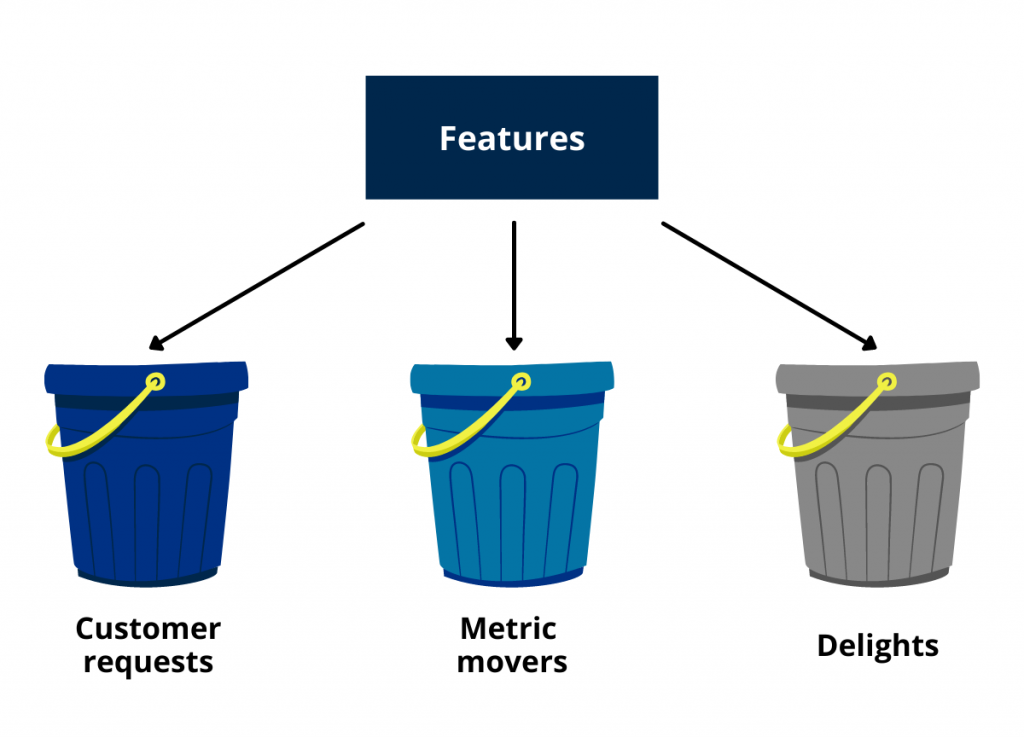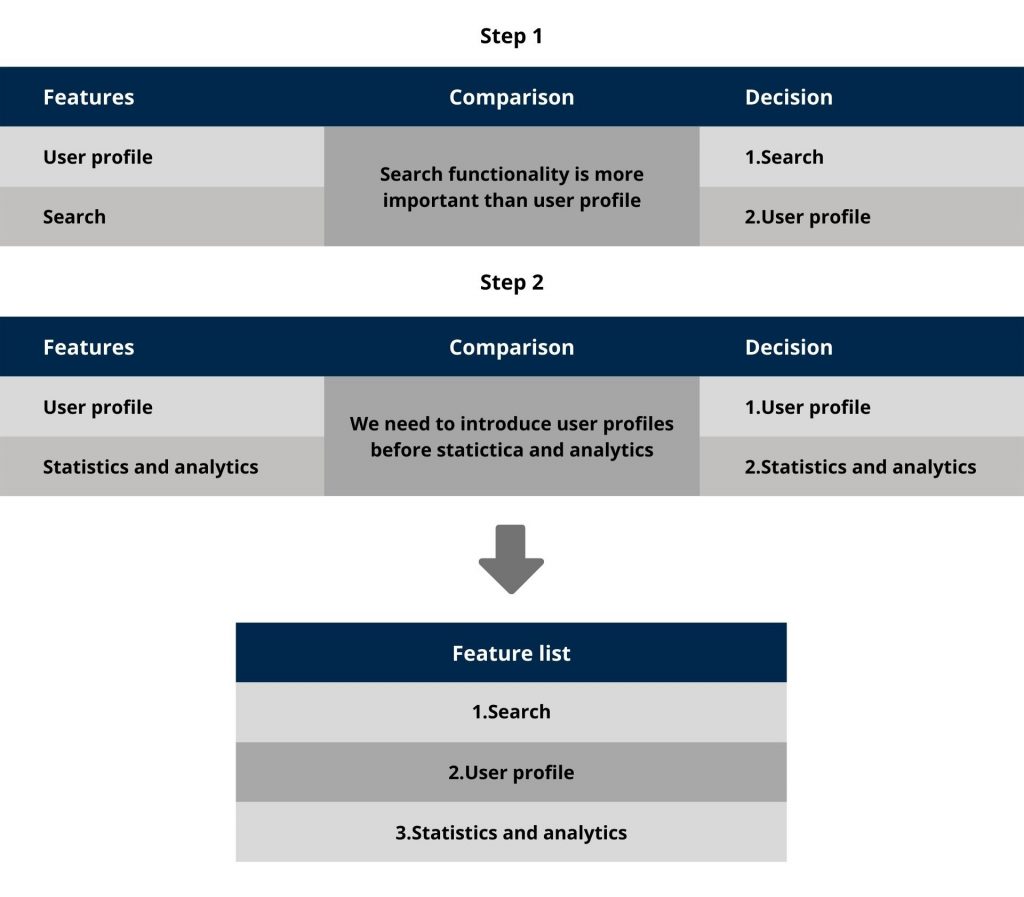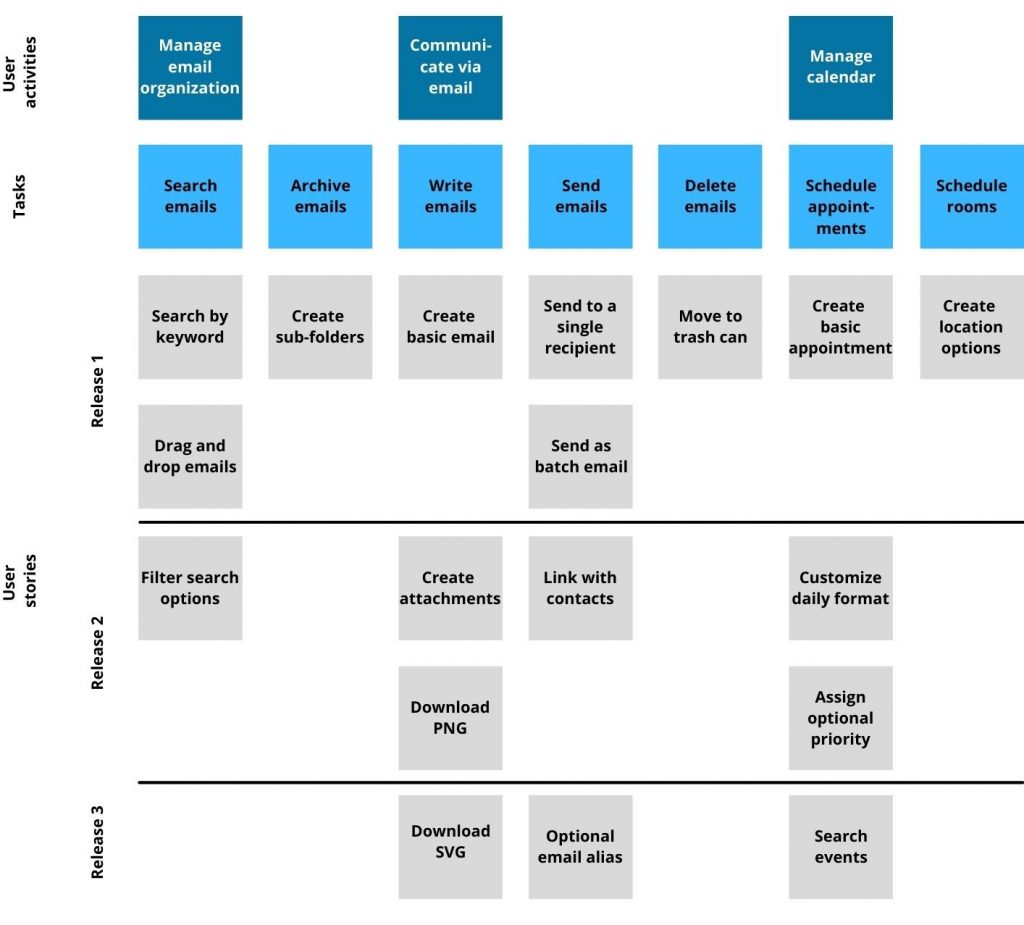You have probably heard the good old scary tale that 90% of startups fail during their first year of operation. The study by SBA's Office of Advocacy shows that numbers are not that dramatic, but they are still very high: only a fifth of businesses survive past a year. Can your startup avoid this fate?
Luckily, all of these failure stories have left us with a huge load of information to analyze in order to avoid the main traps that await us on the road to success.
The main reasons most startups fail are misinterpreting market needs and not building an MVP.
In this article, we’ll try to kill two birds with one stone: We’ll show you how to define the minimal set of features to successfully launch your MVP and to prioritize them for future releases.
Why feature prioritization is important
Why do we pay so much attention to feature prioritization, and why should we use a special method to address it? At a glance, prioritization may look like simply writing down something very obvious; you feel which feature is important and which is not.
Even though intuition is an important trait for an entrepreneur, we recommend not relying on it too much when taking your first steps. The right feature prioritization affects too many aspects of your business success to rely on intuition alone. Below are just a few of them:
It saves you money
Integrating new features is time- and cost-consuming. Developing the wrong features can result in longer time-to-market and, what is even worse, presenting your clients with a product they don’t really need. Prioritization helps you launch faster and skyrocket to the top.
It ensures your product solves a problem
To be in high demand, your app should be helpful. Prioritization helps you explore your clients, define their problems, and find the optimal way to solve them.
It helps you find your distinctive feature
If you are dealing with an actual issue, chances are there are already other products that solve it, and you don’t want to copy them. Your research will help you dive deeper into users’ pains and find the approaches your competitors have missed.
Things to do before starting
You don’t just sit down and put all your features on the list. Well, you do, but before that, you should do some research. This will help you define the true significance of each function.
Here are the steps you should take before proceeding to the main task:
1. Study your audience
When buying gifts for your friends, you try to take into an account their interests and demands to ensure your that present brings them joy. You should do the same for your users. Explore what kind of people they are, and create user profiles. This will help you create a solution that will feel like a gift to them.
2. Identify the problems your clients face
Now that you know your clients, it’s time to dive deeper into their problems. Discover what issue makes their day a little bit more cloudy, and define how your offer can solve it.
3. Learn how they already solve it now
If this problem truly makes your users’ lives harder, they’ll already be trying to fix it. Find out what they use to meet their challenges now. These tools are your competitors. If you can’t find any, that’s not always a good sign. This means the issue you’re trying to fix is either not relevant or rather new.
4. Explore your competitors
Your competitors are not only products like yours. You’ll also be competing with alternative ways to solve (or ignore) the problem you’ve identified. For example, if you’re creating a new car model, your competitor list will include not only other manufacturers but also the use of public transport, bicycles and simply walking to the destination point. Study the strengths and weaknesses of your rivals. This will help you overcome them.
5. Define your UVP
Find out what functions set you apart from your competitors. These can be brand new features or a better realization of existing ones. If these features are attractive enough to make your users select your solution from among the competition, then do your best to showcase them. They will make your product look unique and simply better.
Check out a related article:
20 Methods to Test Your MVP
Yes, this process may take some time, but the knowledge you get will get from it will help you lead your project in the years ahead. And, we promise, it will help you a lot during feature prioritization.
11 feature prioritization techniques for your MVP
Now that we’re done with the preparation, we can proceed to the sweetest part. Below, we list 11 fun and effective approaches you can use to create the feature list for your project.
1. MoSCoW Matrix
This methodology divides features into four groups:
- Must-have features: core functionalities your product can’t do without
- Should-have features: those that are valuable but not vital
- Could-have features: things that are nice to have because they positively affect the user experience but can be realized later if you lack resources now
- Won’t-have-this-time features: functions you can introduce later
This is what the matrix looks like in more detail:

2. Feature Priority Matrix
This method is very close to the MoSCow matrix, but it considers some other aspects of the development process in addition to feature importance:
- Effort: How much time and resource will the development take?
- Impact: How important is the feature to end users, and how valuable is it for your startup?
- Risk: How hard will it be to add the feature?
Based on these characteristics, you can build the new MVP feature matrix:
- Must-haves: the necessary low-risk functionalities
- Can-be-dones: less crucial features that can be added in later updates
- Nice-to-haves: less impactful or riskier features than must-haves but will make you stand out from the crowd; can plan them for the next builds
- Waste of time: risky and unimportant features

Of course, both of these matrixes are not solid. You can reconsider them based on user feedback and market trends.
3. Numerical Assignment or Grouping
This method distributes MVP functionalities between critical, standard, and optional priority groups. You can name them as you like or even add another priority level, but the groups should be clearly defined, and all decision-makers should agree on what they stand for.
Give each group a numerical value and rank all the desired features according to their priority.
Here’s a nice example of how the process might look like:

4. Feature Buckets
Don’t put all your features into one bucket (a new take on the old saying “don’t put all your eggs in one basket”). This methodology splits features into three main types:
Customer requests: the functionalities that large quantities of your clients are asking for
Metric movers: the features that affect your app’s metrics, such as ARPU, ROI, and income.
Delights: small but precious elements that make your app pleasant to use

5. Bubble Sort Technique
This method helps you rearrange your app’s functions by importance.
Start by listing all of your features. Then, compare two adjacent ones, and reorder them by priority. Repeat the procedure until you have no features to reorder.
With each iteration, the most important features will rise to the top of the list, just like bubbles.
Here’s an example:

6. Effort and Impact Method
This technique matches features’ priority with their complexity. Functionalities are evaluated from the perspective of how hard they will be to implement and how much value they will bring.
The challenges include risks and resources demanded. The value is assessed from both customer and business sides.
After that, each feature falls into one of four groups:
- quick wins
- major projects
- fills-ins
- features to reconsider

7. Opportunity Scoring
This method involves communicating with your audience. Reach out to your prospects, and survey them about what functions they would love to see in the next release.
Then, ask them to evaluate similar features of already existing products. This will give you an idea which of your features are in demand and which are not.
8. The Kano Model
The Kano Model is another user-centered approach, but it is a little bit more complex than Opportunity Scoring.
It considers four types of MVP features:
- Threshold attributes: basic functionalities your clients expect you to add
- Performance attributes: features that increase user satisfaction but are not must-haves.
- Excitement attributes: features your customers do not even expect to have but enjoy using when they get them
- Irrelevant attributes: those that affect nothing
This methodology illustrates the ways that new features can affect user satisfaction.

The Kano Model also states that having only basic functions makes it hard to please a client with your solution. Your app looks and feels ordinary, so your clients quickly abandon it. In order to make it valuable, you need to add some performance or excitement features.
The question is which features belong to which group. Ask your clients. Conduct market research, or send out surveys. Then, analyze the feedback, and sort your features by groups.
When planning features for the first release, include threshold functionalities on the list, and pepper them with a few performance and excitement ones.
Check out a related article:
7 Effective Ways to Reduce MVP Development Costs
9. Relative Weighting
This method is the smooth combination of Kano, MoSCoW, and numerical approaches. You give a certain value to each feature, so your team gets a clear view of how impactful it is.
It also counts the negative effect of not introducing functionalities.
The technique considers the following aspects:
- Benefit: the pros of introducing the feature
- Penalty: the cons of not introducing it
- Cost: the cost of feature development
- Risk: how challenging it is to develop a certain feature
Calculate the importance of each feature by using the following formula:

After that, each function gets a value between 1 and 9 so that you can prioritize them quite easily. The initial assessment, though, may require cooperation between the client and the development team.
10. Speed Boat Method
This is a playful method that requires imagination and collaboration.
Imagine that your product is a boat that needs to get to a port of destination (your business goal). Each functionality can either accelerate your boat or act as an anchor.
Organize the brainstorming session so that you and your team discuss which features are significant and add some fuel to your motor boat and which features slow down the workflow without bringing any use.
11. User Story Mapping
User story mapping is an extremely powerful prioritization method. It involves predicting users’ interactions with your program so that you can define which features they’ll look for.
Being a highly effective tool, this method requires collaboration among all kinds of stakeholders: sponsors, founders, developers, designers, and more.
Your first task is to define the goals your clients want to reach using your solution.
Next, divide each goal into small activities a user does to reach it.
Then, create user stories. They should include actions your users perform and benefits they want to get by doing so. The result should be something like: Being a [type of user], I want to [action] to get [benefit].
Now, it’s time to map all your findings. User stories should be connected to the corresponding activities isted in descending order starting from the stories that include high priority functionalities.
As a result, we get a map of the usage sequence, where the Y-axis outlines the usage flow and the X-axis defines the value of the feature.
Once you have mapped all features, you can distribute them between several releases.

Sum up
As you can see, there are quite a lot of techniques that you can apply (you don't need to apply them all; don't worry). The key idea here is to put your client in the spotlight. After all, they’ll be the ones to define your startup success.
Try not to analyze MVP features on your own. Incorporate different specialists on your team, and don't be afraid to ask for user feedback.
Of course, you still can request expert consultation. At Intersog, we run special workshops and offer MVP development services. Feel free to contact us for details.
Leave a Comment